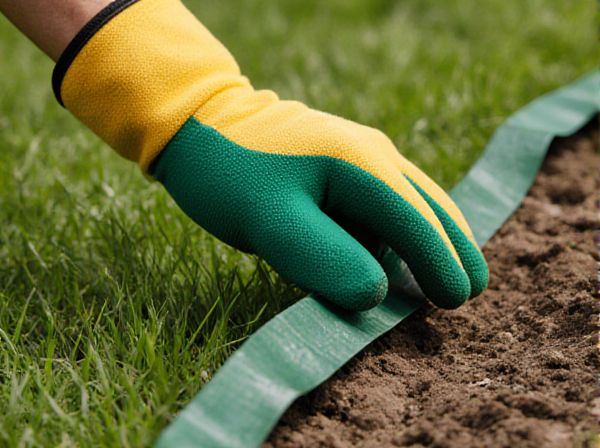
Garden Edging vs Lawn Border Illustration
Garden edging creates a defined separation between flower beds and lawns, enhancing the aesthetic appeal and preventing soil erosion. Lawn borders serve a similar purpose but are often made from more durable materials like metal or stone, providing a stronger barrier against grass encroachment. Both options improve landscape organization, but garden edging is typically more flexible for creative designs, while lawn borders offer greater durability.
Table of Comparison
| Feature | Garden Edging | Lawn Border |
|---|---|---|
| Purpose | Separates garden beds from lawn or paths | Defines lawn edges and prevents grass spread |
| Material | Plastic, metal, stone, wood | Plastic, metal, concrete, rubber |
| Installation | Usually sunk into soil along garden bed | Set flush with lawn surface |
| Flexibility | Available in flexible or rigid forms | Typically rigid for clear lawn definition |
| Maintenance | Low to moderate, occasional realignment | Minimal, mainly cleaning debris |
| Cost | Moderate, varies by material and length | Low to moderate, depends on material |
| Visual Effect | Decorative, enhances garden design | Functional, emphasizes lawn shape |
Understanding Garden Edging and Lawn Borders
Garden edging and lawn borders serve distinct functions in landscaping; garden edging typically defines flower beds and pathways using materials like stone, metal, or plastic, providing a clear separation that helps contain soil and mulch. Lawn borders specifically focus on separating the grass from other garden areas, preventing grass from encroaching into flower beds while maintaining a neat, organized appearance. Selecting the appropriate material and style for each enhances garden structure and supports healthy plant growth by minimizing maintenance and controlling invasive grass roots.
Key Differences Between Garden Edging and Lawn Borders
Garden edging and lawn borders serve distinct landscaping functions, with garden edging primarily designed to separate flower beds and paths from the lawn, enhancing aesthetic appeal and preventing soil erosion. Lawn borders, on the other hand, provide a defined boundary around the entire lawn area, often using materials like bricks, wood, or metal to contain grass growth and create a polished appearance. The key difference lies in their placement and purpose: garden edging emphasizes protection and decorative separation within garden beds, while lawn borders offer structural containment and perimeter definition for lawns.
Benefits of Installing Garden Edging
Installing garden edging enhances soil retention by preventing mulch and soil from spilling into the lawn, creating a clean separation between garden beds and grass. It reduces maintenance efforts by minimizing grass encroachment and weed growth along garden borders, promoting healthier plant growth. Garden edging also improves aesthetic appeal, providing a defined structure that complements landscape design and boosts curb appeal.
Advantages of Lawn Borders in Landscape Design
Lawn borders provide a clean, defined edge that enhances the overall aesthetic appeal and structure of a landscape design. They prevent grass encroachment into flower beds, reducing maintenance and promoting healthier plant growth. Durable materials like metal or stone used in lawn borders offer long-lasting functionality and can complement various garden styles.
Materials Used for Garden Edging
Garden edging materials commonly include natural stone, brick, metal, plastic, and wood, each offering unique durability and aesthetic qualities. Natural stone and brick provide a classic and long-lasting border resistant to wear and weather, while metal edging, such as aluminum or steel, offers sleek, flexible options with minimal maintenance. Plastic and wood are cost-effective alternatives, with plastic being easy to install and resistant to rot, and wood delivering a warm, organic look but requiring regular treatment to prevent decay.
Popular Choices for Lawn Border Materials
Popular lawn border materials include natural options like stone, brick, and wood, which offer durability and aesthetic appeal in garden edging. Metal and plastic borders are also favored for their flexibility, ease of installation, and weather resistance. Selecting the right material depends on landscape design, maintenance preferences, and budget constraints to achieve a clean and functional lawn edge.
Design Aesthetics: Edging vs Border
Garden edging creates a clean, defined separation between flower beds and lawn areas, enhancing the overall design aesthetics with subtle, low-profile lines that maintain a natural flow. Lawn borders, often more robust and decorative, serve as a focal point by incorporating materials like stone, brick, or metal to provide a striking contrast and structured look. Choosing between garden edging and lawn borders depends on whether the desired landscape design emphasizes seamless integration or bold, ornamental boundaries.
Installation Process: Garden Edging vs Lawn Border
Garden edging installation typically involves securing flexible or rigid materials such as plastic, metal, or stone along the garden perimeter with stakes or spikes, allowing for easy customization and removal. Lawn borders often require more robust installation, including concrete foundations or lawn edging spikes to firmly hold heavier materials like bricks, pavers, or metal strips in place for long-term durability. Proper preparation of the soil and precise alignment are crucial in both methods to ensure a clean separation between garden beds and lawn areas while preventing grass encroachment.
Maintenance Tips for Edging and Borders
Garden edging and lawn borders require regular maintenance to prevent soil erosion and maintain crisp, defined lines. Use a string trimmer or hand edger monthly to trim grass and weeds along the edges, ensuring a neat appearance. Applying mulch or gravel helps suppress weed growth and reduces the frequency of edging needed, preserving the integrity of both garden edging and lawn borders.
Choosing the Right Solution for Your Landscape
Garden edging defines clear boundaries between flower beds and lawns, enhancing visual appeal and preventing soil erosion. Lawn borders provide a more robust barrier, ideal for high-traffic areas or slopes, ensuring grass and mulch stay separated. Selecting the right solution depends on landscape design, maintenance preferences, and the specific function desired for plant containment and overall garden aesthetics.
Garden Edging vs Lawn Border Infographic

 gardendif.com
gardendif.com